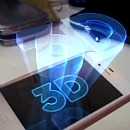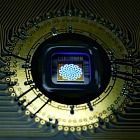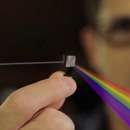Future Technology Devices
 Future technology devices, such as smartphones, will soon use
virtual reality
technology to float holographic 3D images in mid-air.
Future technology devices, such as smartphones, will soon use
virtual reality
technology to float holographic 3D images in mid-air.
According to the United Nations specialized agency ITU (International Telecommunication Union) mobile broadband over smartphones has become the fastest growing segment of the global information and communication technology market.
Mobile broadband connections over 3G networks has an annual growth rate of 40 per cent. Almost 50% of everyone on the planet is covered by a 3G network, which refers to the 3rd generation mobile telecommunications technology used for mobile internet access.
It's expected that smartphone usage will reach 2 billion by 2017 making it the most popular device for accessing the internet.
Yet despite this amazing growth, there is a drawback - it is the limitations of using small-sized screens.
But for inventor Hussein S. El-Ghoroury, future mobile devices will not have this limitation.
Instead of looking at a couch on your small screen, you could project a full-sized three-dimensional hologram of it right in front of you. You could move it around, view it from any angle, and even interact with it.
Projecting holograms is a complicated process especially if your trying to put it into something as small as a smartphone.
 El-Ghoroury has spent the last
nine years developing virtual reality technology that miniaturizes a
holographic projector into a tiny
circuit chip.
El-Ghoroury has spent the last
nine years developing virtual reality technology that miniaturizes a
holographic projector into a tiny
circuit chip.
It is called the Quantum Photonic Imager and it can control the color, brightness and angles of light beams to display an image in the air with a resolution of 5,000 dots per inch.
“The highest resolution images, of course, are holograms. And because we can pack so many pixels, it’s enough to create these kinds of images,” says El-Ghoroury, whose California company Ostendo Technologies has deep-pocketed financial backers like DARPA and PayPal founder Peter Thiel.
El-Ghoroury expects his holographic imaging chips to be available in smartphones and other devices by 2016.
Sources: ostendo.com; online.wsj.com; creativecommons.org
Future Technology Device
 Technology at our fingertips has allowed us to
do amazing things and entrepreneur-inventor
Dror Sharon has just taken this convenience
to the next level.
Technology at our fingertips has allowed us to
do amazing things and entrepreneur-inventor
Dror Sharon has just taken this convenience
to the next level.
He has created a handheld molecular scanner (spectrometer) that will give you the chemical composition of objects in your environment.
Here is how it works.
You point the scanner's light beam at an object. An optical sensor then absorbs the light reflected from the object. The scanner forwards information about the light to a cloud-based service for analysis. The results are then sent back to your smartphone in a matter of seconds.
 So what can it tell you?
So what can it tell you?
It can tell you if a watermelon is sweeter than another, or if an avocado is ripe. You can find out how much protein is in a shake, or the carbohydrates, calories, fat or sugars in a hamburger.
In fact, you can get nutritional data on all kinds of foods - fruits, cheeses, sauses, salad dressings - even your vitamins - in a manner of seconds.
The possibilities for applications are endless. The device is called a SCiO, from latin "scio" meaning "to know", and it could be used to detect the content of cosmetics, plants, clothing, jewellery, precious gems, plastics and so on.
Sharon, an engineer with an MBA from the Massachusetts Institute of Technology, created his invention so users could access intimate details of the things around them.
"I think it will change the world in many ways," said Sharon. He said his device could be used to monitor car tires, fuel tanks, soil or even the human body.
 It could have life-saving uses, such as identifying
contamination, toxins, bacteria and harmful
chemicals in the environment.
It could have life-saving uses, such as identifying
contamination, toxins, bacteria and harmful
chemicals in the environment.
Sharon is encouraging developers/inventors to build custom applications for his invention and to help build what he calls - "the world's largest database of matter."
Sharon, whose company Consumer Physics has financial backing from angel investors such as flash drive inventor Dov Moran, has also raised over $2.7 million in crowdfunding.
The Scio is expected to be available to consumers in late 2015 or early 2016.
Sources: consumerphysics.com; kickstarter.com




